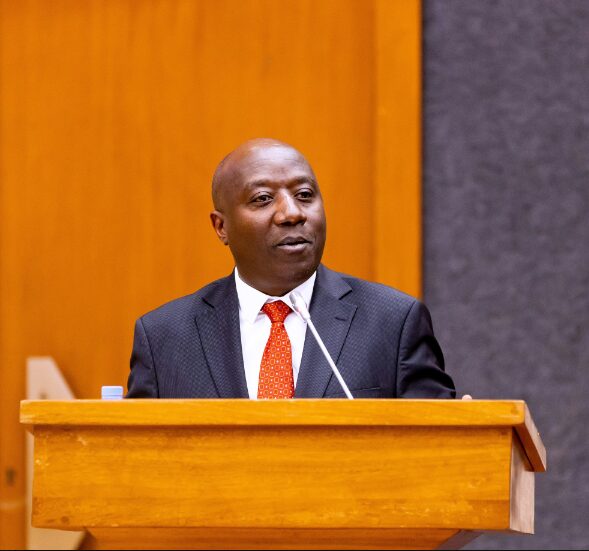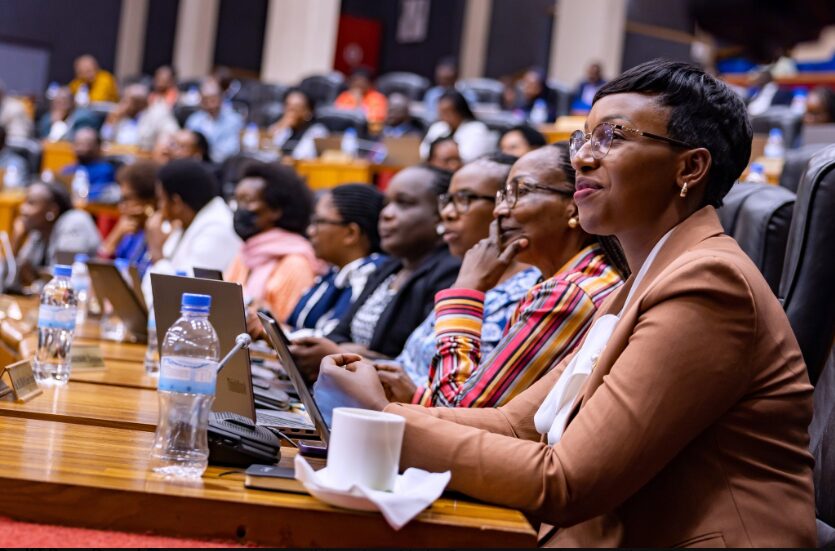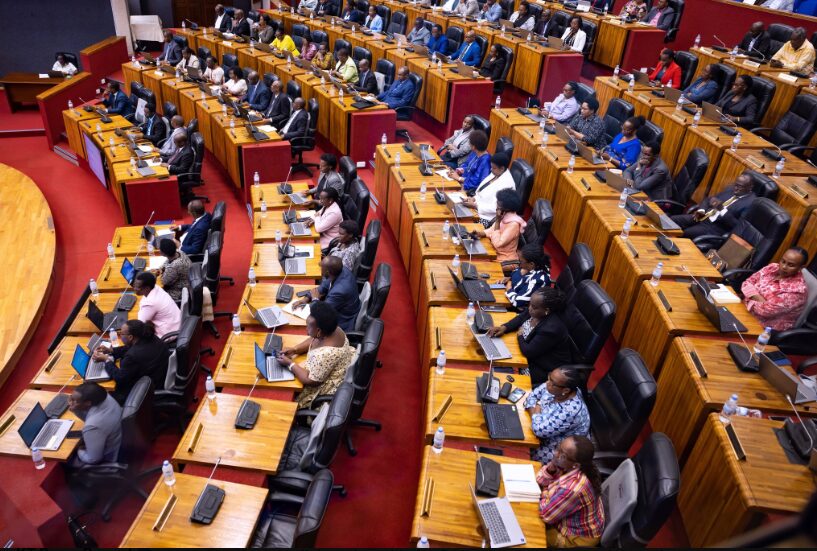
Prime Minister, Dr. Edouard Ngirente
The Prime Minister, Dr. Édouard Ngirente has presented the achievements made in the seven-year National Strategy for Transformation (NST1) 2017 –2024 which indicate progress but also calling for more work ahead towards sustainable development.
Presenting the achievements this June 5, 2024 to both Houses of Parliament (chamber of deputies and Senate), Ngirente said that some of the set goals were attained while others were derailed by the COVID-19 pandemic, global economic and climate shocks.
NST1 came at a unique moment in the country’s development trajectory to enable Rwanda to see the crossover from Vision 2020 towards Vision 2050 as a mandate of the government.
The strategy had three key pillars, namely: economic, social and governance transformation and Ngirente highlighted key sectors of intervention which were focused on in these pillars.
In agriculture and livestock, the objective was to increase production, increase seeds locally, use of fertilizers, land consolidation and irrigation and increase of dairy products.
For instance, over 773,00 hectares of cultivable land were consolidated against the 980,000 hectares target, irrigable land reached 71,585 ha from 48.508 hectares and fighting soil erosion was done on 142,000 hectares against the planned 142,500 hectares.
Through government subsidy programs (Nkuganire), needed seeds multiplication came from 3,416tons to 6,131tons as a result of privatization to availing seeds and training farmers, while use of fertilizers increased from 32kg/ha to 70kg/ha (against the 75kg/ha target) and government supplied fertilizers increased from 45.000tons to 96,000.
The PM said that the use of tech in agriculture has not been an easy task – was not easy but the government will focus on availing more tilling machinery for farmers.
Milk and its collection increased from 56 collection centers to 134 collection centers and the produce increased from 776 million liters of milk to 1billion liters while animal and livestock Insurance (in which the government offers 40% subsidies also increased.

Members of Parliament
“We want more participation in the animal insurance and crop insurance in the next coming years,” Ngirente said.
Ngirente said that this intervention area is expected to improve despite effects of climate change that affected production due to dry spells and resulting in market price inflation.
Infrastructure
Ngirente stated that almost all districts and city of Kigali have updated their land use masterplans (14 completed, 8 underway and 6 to be done soon), and citizens are living in planned settlements from 87 new settlements constructed (inhabiting 17.000 high risk and vulnerable families).
Though Senators and MPs questioned the quality and standards of roads in Rwanda, the PM stated that at least most major roads (in districts) are tarmac and there was an increase in networks by 1,700Km and 230km of new roads in Kigali and other major towns, and 4,137km of feeder roads constructed to connect more places.
The report showed that street lights on the roads were increased from 663 KM to 2.185KM and the PM stated that more roads will be upgraded in near future.

Rwanda had planned to reach 100% access to clean water and electricity by 2024. The PM showed that seven water treatment plants have been constructed resulting in an increase of water from 182.120 m3 in 2017 to 329.652 m3 to date.
On access to electricity, the PM said that it had increased from 34,4% (931.552 homes) to 76,3% (2.629.673 homes) and the target is to increase access as the population increases.
“The development agenda doesn’t stop. In the next strategy we plan to increase water access by constructing more plants to improve welfare… As the number of homes increase, we will bring electricity to new homes,” Ngirente promised.
In Industry, the plan was to increase local production and improve exports the mining and financial service sectors.
Here, three pharmaceutical plants were constructed (and others in construction materials, mosquitoes net plant, fertilizer but with a plan to attract more investments as Rwanda plans to construct new special and industrial zones.
Ngirente revealed that the role of manufacturing in increasing the GDP was targeted at 21.7% and this has reached 22% and local plants production has reached 10% per annum and remains progressive.
The industry sector also played a key role in creating jobs (1.374.214 jobs annually out of the 1.5million targeted) and the PM said that this target was not fully achieved because of the Despite COVID-19 pandemic shocks.
“We didn’t achieve this goal because of COVID 19 and some businesses closed, jobs were put on hold. Though there is a slight shortfall we wanted to create more jobs for youths,” he said.
Rwanda also constructed four mineral processing plants (Gold, Cassiterite, Coltan, and Precious stones) which has seen mineral export revenues increase exponentially from $374m to $1.1billion as of 2024.
To promote cross border trade, the country also established nine markets and one lake port (Rubavu) and an inland port in Masaka sector in Kigali city.
The tourism sector, which remains biggest forex earners, also grew from $370million to $ 620million of which $ 95million was from hosting meetings and conferences (MICE).
ICT: The PM also revealed that 97% of the country is covered with internet connectivity and users stand at 68.9%, while Rwandans between 15 and 35years (85%) know how to use internet based technology.
e-Services have also increased from 155 in 2017 to 684 and the government plan is to use more e-services, according to Ngirente
Ngirente revealed that 93% of persons above 18 years are financially included as more services are disseminated to promote access to credit and savings.
Education: in NST1, Rwanda urgently planned to improve quality of education by constructing more classrooms- to reduce overcrowding in schools but also increase capacity of teachers and their welfare.
The PM stated that 27.000 classrooms were constructed, and from only 200 sectors that had technical schools, Rwanda has 395 of them out of the 416 sectors in the country.
 Ngirente stated that teachers’ career paths and salaries have improved but the Teacher’s SACCOs received more funding- for example injecting Rwf1billion to Rwf5billion increase from one year to another, while school feeding program has ensured all children get food and many have return to school with improved performance as teacher numbers increased from 71.041 to 110.523.
Ngirente stated that teachers’ career paths and salaries have improved but the Teacher’s SACCOs received more funding- for example injecting Rwf1billion to Rwf5billion increase from one year to another, while school feeding program has ensured all children get food and many have return to school with improved performance as teacher numbers increased from 71.041 to 110.523.
Health: Since 2017, seven hospitals have been built (Gatunda, Gatonde, Munini, Nyabikenke, Byumba, Nyarugenge and IRCAD) while 12 new health centers and health posts increased from 473 to 1.252 enabling Rwandans to access healthcare within a short distance.
Health insurance (mutuelle de sante) reached 90.6% from 83% in 2017 and life expectancy increased 66-69.6 years and the PM said that the government doesn’t intend to see this fall down as it is essential in providing services to all.
The next NST2 is under preparation and is expected to be launched this month.

